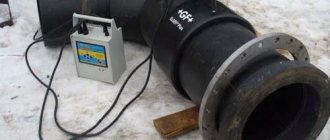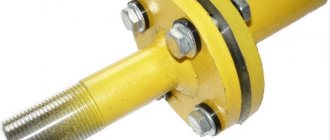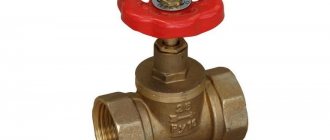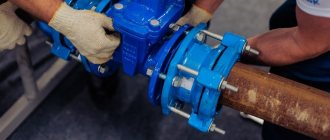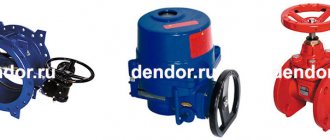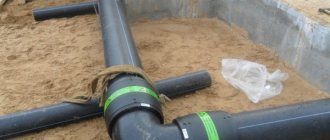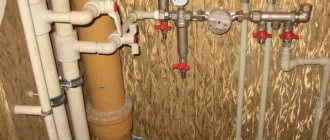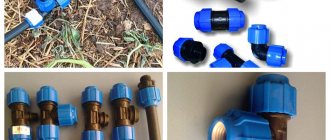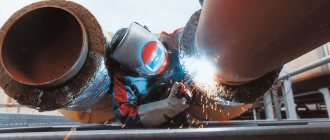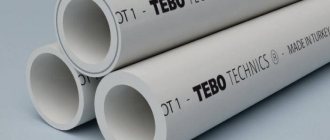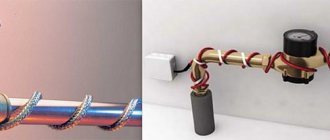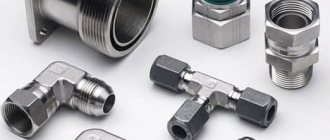Flanges are steel disks (rings) of various configurations; they are designed for quick-release connections on pipelines. They are attached by welding to pipe sections. They are necessary for installing shut-off valves, metering devices, and when installing new bends. They are put on the edge of the pipe. The most effective way to attach a flange to a pipe is welding. The rings must be fixed without distortions, strictly along the cross-section of the pipe.
Welding of flanges is carried out in several ways; each technology has its own nuances that must be taken into account to obtain a high-quality sealed seam that does not impede the flow of the transported liquid.
Flange types
Before talking about welding flanges, it is important to study their design features. Dimensions and shape are regulated by GOST or technical specifications. They vary in geometry, size, and are made from high-carbon or alloy stainless steels or forgeable cast iron.
Based on functionality, there are two groups of flanges:
- reinforcement;
- intended for vessels and apparatus.
Structurally, flanges are divided into several types:
- Collar type - used on high pressure systems. The neck tapers along a cone; it is made in the form of a conical centralizer that distributes the flow pressure. According to the American classification, it is called “Lap Joint” (lap welded). Attached with a continuous bead or V-shaped seam.
- Socket-shaped - used on technological lines of small cross-section, designed for high pressure of the transported medium, marked “Socket-welding” (with a cavity for the seam). It is welded only from the outside; it is necessary to leave a gap of up to 1.6 mm in case the pipe expands when heated with a hot medium. The corner seam is made end-to-end.
- Slip-on or through - attached at a distance of 3 mm from the edge of the pipe, international designation “Slip-on” (with a through hole). Fixed on both sides with a fillet weld - welding to the outer and inner walls.
- Blind - performs the function of a plug, forms a collapsible connection with the pipe, and may have the inscription “Blind flanges”. It is not attached by welding, it is held on by a bolted connection.
- Flat - consists of a ring and a plate, designed for low pressure up to 2.5 MPa, only the ring is attached to the outer edge of the pipe by welding, the plate remains movable.
- Threaded - used on embedded fittings where there is threading or rolling, marked “Threaded flanges”. It is attached to the end of the pipe mechanically, rarely additionally fixed by welding.
Product classification
The general structure of the part is a ring and a plate with holes along the edge. To ensure tightness between the elements, a rubber gasket is also installed in accordance with the purpose of the pipeline - acid-resistant, heat-resistant. The ring and plate are connected using fasteners - bolts with nuts or studs.
According to GOST, there are several different types of flanges. According to the drawings, their differences are clearly visible.
Accordingly, welding of parts to the pipeline is carried out somewhat differently.
- Collar type – a characteristic feature is a welded neck in the form of a conical concentrator. This shape allows the pressure to be distributed more evenly. The collar model is designed for communications with high pressure and high temperature media. Welded with a continuous or V-seam.
- Bell-shaped - used on pipes with a small diameter operating under high pressure. The downside of the product is some instability to corrosion. The socket part is welded from the outside using a fillet weld. A clearance of 1.6 m must be maintained to neutralize the effect of thermal expansion.
- Through - or freely rotating. Welding of a through pipe to a flange according to GOST is not carried out, since the through option is used specifically so that the part can be replaced as necessary. The photo shows a through flange connection.
- Blind - a flat disk with holes. This device is necessary for plugging the ends of the pipeline. The element is not dismountable, but it is only fixed and not welded.
- Flat – ring and plate are the same size. Welding a flat flange to a pipe involves attaching a ring while the plate remains free to rotate. It can withstand pressure up to 2.5 MPa.
- Slip-on - to use it, the edges of the pipes must be perfectly straight, so it is not as versatile as collar models. The cap is welded with fillet welds on the outer and inner sides.
- Threaded - used on small diameter pipelines where it is possible to make a thread. Welding is used extremely rarely during its installation.
Flange welding methods
The tightness of the system depends on the correct connection of the pipeline elements. Welding of the disk is carried out using two methods:
- Butt welding involves the formation of a seam along the entire circumference of the rolled product in one place.
- Welding of the mounted disk along two walls: outer and inner.
Working with flanges requires experience; such welding is not trusted to beginners. Any misalignment of the welding surfaces leads to depressurization of the butt joint and increases the risk of a breakthrough in the high-pressure main pipeline.
Regulations
For all of the above cases, clauses 3.2.14, 3.2.15 and 3.2.16 of the Rules for the Construction and Safe Operation of Process Pipelines (PB 03-108-96) are applicable. They say the following:
Design and work must be carried out in such a way that in the future it is possible to control the weld and, if necessary, carry out heat treatment. If the project uses pipes with a metal thickness of less than 8 mm, then at least 50 mm should be retreated from one weld to another, if more than 8 mm - 100 mm. In all other cases, there must be a distance between welds that is three times the nominal thickness of the material.
Welding the flange to the pipe
Before welding work, edge preparation is carried out. The seams are cleaned until shiny. When independently assembling metering units or inserting shut-off valves, it is important to take into account the thickness of the sealing gasket; the disc is installed taking into account the thickness of the rubber. The bolt heads on the flanges are located on one side only. The ends protrude at least 3 threads. The disk mirror is always located above the seam and edge; the edge of the rolled product should not extend beyond the plane of the disk. Tack joints help to weld the flange to the pipe evenly; when the disk is immobilized, you can start making seams.
At a pressure of up to 10 MPa, welding is carried out without a bevel; at a high pressure, up to 25 MPa, welding is carried out with bevels.
Rotators are used to weld flanges to steel pipelines. They give the unit mobility, improve access to the working area, and facilitate the welding process. During the welding process, the electrode remains stationary, the assembly gradually rotates around its axis. The rotator is used to finish cleaning the seams, priming and painting the flange assembly.
Important points when assembling a flange connection:
- it is necessary to fasten the disk perpendicular to the pipeline, a control triangle and a probe are used for checking, the permissible deviation is 2% of the outer diameter;
- the axes of the bolt holes on the two disks must coincide; alignment is checked with a level and plumb line. Permissible deviations: a) 1 mm for holes with a diameter of 18 to 25 mm; b) 2 mm for diameters up to 41 mm.
Permissible disc deviation - 2% of the outer diameter
The “boat” technique is used for connections without backlash; the edges are welded to a great depth. If the gap is within 1.5 mm, welding is performed with transverse oscillatory movements, the electrode is held at an angle of 30° to the surface of the pipe. A backlash of 4–5 mm is formed using a fillet seam with large stitches (cathetes). If the gap is large, two penetrations are allowed.
Fastening methods
The most universal is the contact method of welding the flange. It is easy to master: the technology itself is not new, and the technical equipment for its implementation is mass-produced by Russian enterprises. The advantage of the contact method is that it allows you to attach elements to pipe structures that have different wall thicknesses and different diameters. Its popularity is also due to its high productivity, almost complete automation of the process, and the absence of additional consumables (gases, electrodes, etc.).
Gas welding allows you to create strong and dense nodes in communications, but is not economical. Labor-intensive work, which can only be carried out by highly qualified gas cutters, involves a large consumption of acetylene and oxygen.
The automatic attachment of fittings with electrodes is also inferior in efficiency to the contact method: the master can burn through the seam row if the thickness of the pipe walls is less than 5 mm.
In Russia, manual arc welding is widely used. But it is also labor-intensive and does not guarantee the required strength of the welding scar.
Weld quality control
To check the tightness of the flange fastening, an ultrasonic method is used. The seam is checked:
- on cracks;
- the presence of slag inclusions, sagging, cuts;
- Burns, craters, and porosity are unacceptable.
Flaw detection is also carried out by metallography. At critical connections, the quality of welding of flanges to pipes is checked by radiographic non-destructive testing.
Knowing the intricacies of fixing the flanges, if necessary, you can independently weld the disk to a section of the plumbing system.
Technical recommendations
It is not recommended to weld a flat flange to an outlet without a coil, because the connection is made with a fillet weld - the result is a rigid structure that experiences complex loads. The tightness of the seam under certain conditions (for example, during thermal expansion when a hot medium is supplied) may be broken.
Collar (“with a skirt”) and free (with flange) flanges are welded with a simpler and more reliable butt weld - a connection that is resistant to tensile and compression loads is obtained.
When connecting a flange to an outlet or transition, it is necessary to provide for the possibility of free insertion/removal of bolts or studs when assembling/disassembling the flange.
The need to weld a flange to a pipe arises in organizations involved in the construction, maintenance or servicing of pipelines. not only supplies rolled metal throughout Russia, but also carries out metal processing. Our specialists know everything about welding and methods of installing metal products, so they will be able to weld flanges in accordance with the current welding regulations.
Subtleties of the process
Technological features of the welding process depend on the type of flanges. Flat flanges are mounted only on straight sections of pipe - unlike collar models, they cannot be welded to bends. Differences in welding methods for flat and collar flanges are explained by different types of seam joints (butt or corner) and the nature of the structure being formed. Flat-flange connections are made with a fillet weld, forming a rigid structure, which, when high-temperature substances are supplied, can collapse due to the difference in the coefficients of thermal expansion. Collar flanges are welded with a butt weld that can withstand significant temperature fluctuations.
PC Ferrum Hand employs qualified welders, craftsmen, engineers and technologists. They are certified by NAKS (state body for welding control), confirmed by issued certificates. The work is carried out using certified welding equipment. If the customer needs to weld a flange according to all the rules, we will do it professionally, quickly, and at affordable prices.
Sale of rolled metal in St. Petersburg and Leningrad region
Stages of welding work
The methods of welding work, the equipment and materials used may differ, but the sequence of the process is the same:
- Preparing the areas to be welded - cleaning the metal along the edges to a shiny state.
- Edge processing – chamfer cutting at an angle of 30°.
- Bringing the two connected ends together, fixing them in a stationary state. To do this, a wire with a diameter of 2 mm can be placed in the gap between the surfaces to be welded.
- Tack welding of the joint in three places, ensuring immobility of the structure during welding.
- Carrying out welding work - melting the metal of the electrode and the edges to be welded, filling the seam with it, followed by crystallization to form a permanent connection of two elements.
- Cleaning the seam, removing electrode slag.
As a result of correctly carried out processing, the flange element is welded to the pipe without distortions, the seam will be tight and will subsequently withstand increased pressure in the system.
How to buy steel welded flanges, prices and price list
In order to see the price for any flange, flat, collar, loose or mating, you can request a price list from the sales department by phone +7(351)735-95-75 or by email This e-mail address is being protected from spambots, for You must have Javascript enabled to view it. You can also send a request to the specified coordinates and get the best prices
, since the cost changes and the price list is not always updated quickly, issue an invoice and buy. You can arrange for the goods to be shipped. The price of flanges can be viewed by visiting the price list page for pipeline fittings. You can download it in a format convenient for you to your computer and keep it always at hand. There is also the cost of gate valves, valves, bends, taps and other fittings.
